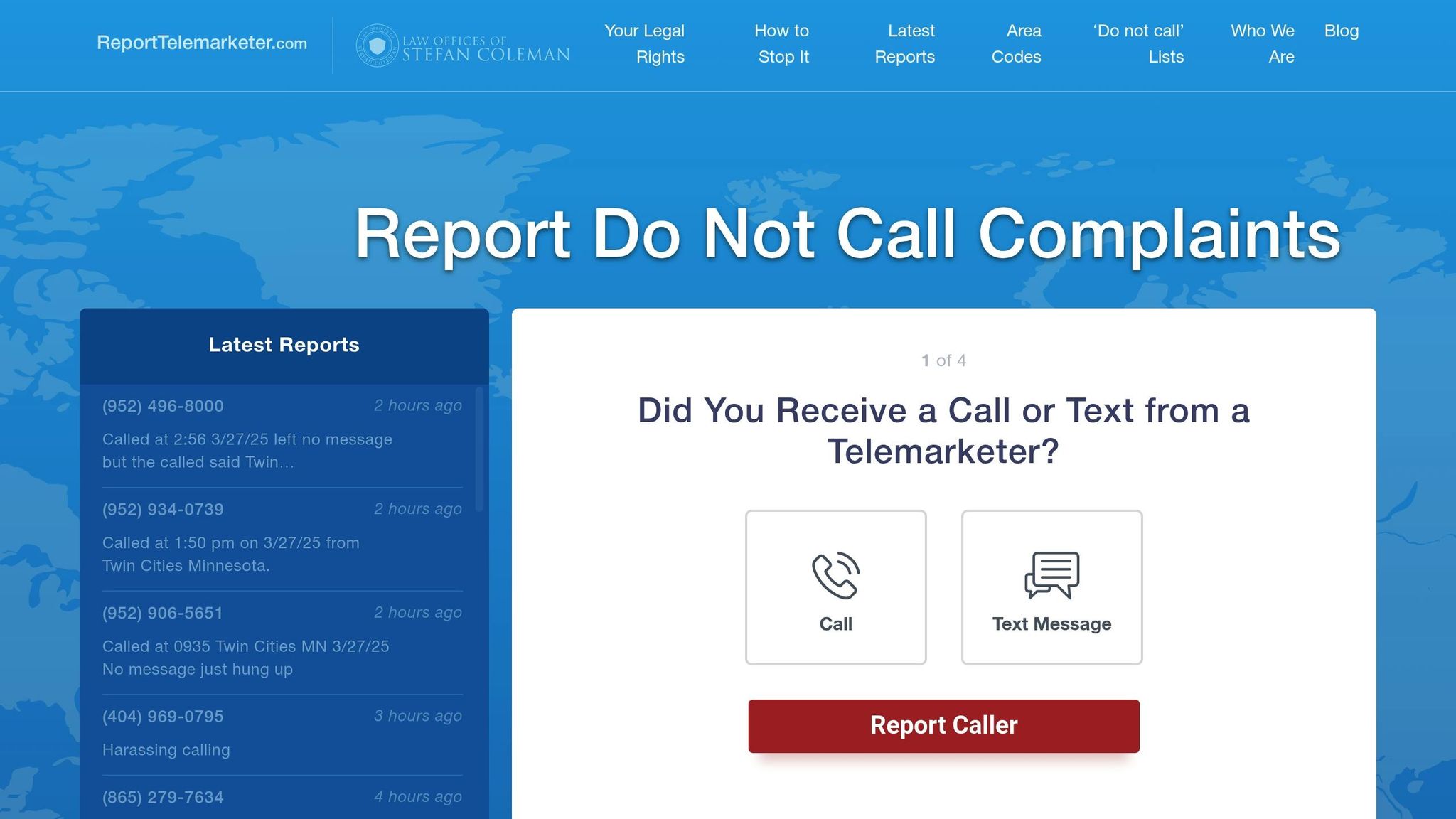
Unwanted telemarketing calls are frustrating, but reporting them can feel overwhelming. Here’s what you need to know to take action effectively:
- Identify the Caller: Telemarketers often hide behind spoofed or rotating numbers. Record details like the time, number, and company name to help uncover them.
- Know Your Rights: Laws like the TCPA protect you. Telemarketers must follow rules about calling hours, consent, and honoring opt-outs.
- Keep Records: Document every unwanted call, including the caller’s details and your responses, to build a strong case.
- Report to the Right Agency: Options include the FTC, FCC, or state attorney general. Services like ReportTelemarketer.com simplify this process.
- Stay Engaged: Follow up on your reports and provide additional information if requested.
Quick Tip: Tools like ReportTelemarketer.com can investigate callers, enforce legal action, and stop unwanted calls for free. Start by logging call details and filing a report to protect your rights.
How To Report Nuisance Calls? – CountyOffice.org
1. Finding Out Who Called
Identifying telemarketers can be tricky since technology allows them to hide their identities. But there are some effective ways to figure out who’s behind those annoying calls.
Hidden and Fake Phone Numbers
Telemarketers often use these tactics to disguise their numbers:
- Number spoofing: Showing fake caller IDs that look like local numbers.
- Anonymous calling: Blocking their number from appearing altogether.
- Rotating numbers: Switching to different numbers for each call.
These tricks make it tough to trace the real source of the calls. However, keeping detailed records and reporting the calls can help uncover who’s responsible.
How to Record Caller Details
When you get an unwanted call, jot down these key details:
| Information to Collect | Why It Matters |
|---|---|
| Date and time of call | Helps identify patterns in the calls. |
| Phone number displayed | Tracks how often numbers change. |
| Company name mentioned | Links calls to specific businesses. |
| Product/service offered | Pinpoints the marketing campaign. |
| Representative’s name | Adds another layer of verification. |
| Script details or keywords | Connects similar calls together. |
Once you have this information, tools like ReportTelemarketer.com can help you dig deeper into the caller’s identity.
Using ReportTelemarketer.com for Caller ID

"Once you report the calls to us, we start tracking down the telemarketer using our proprietary tools and systems." – ReportTelemarketer.com
ReportTelemarketer.com specializes in identifying the real people or businesses behind masked numbers. The platform has already helped more than 30,000 people stop unwanted calls by investigating reported numbers and pursuing legal action when necessary. Here’s how they assist:
- Track down the actual business behind disguised numbers.
- Identify possible violations of consumer protection laws.
- Collect evidence that could support legal action.
- Link complaints from multiple individuals to strengthen cases.
Even if a caller isn’t identified right away, every report you file adds to a growing evidence base, making it easier to take action in the future.
2. Knowing Your Rights
Main Consumer Protection Laws
It’s important to know your rights when dealing with telemarketers. The Telephone Consumer Protection Act (TCPA) outlines several protections designed to safeguard you:
| Protection Type | What It Means for You |
|---|---|
| Calling Hours | Telemarketers can’t call before 8 AM or after 9 PM in your local time zone. |
| Do Not Call List | Once you register, companies must stop calling you within 31 days. |
| Consent Requirements | Automated calls or texts require your written consent. |
| Identification Rules | Callers must clearly state their company name and provide contact information. |
| Opt-Out Rights | If you ask to stop receiving calls, companies must comply immediately. |
These rules apply to calls made to both cell phones and landlines. Telemarketers who break these regulations can face hefty penalties.
Common Legal Myths
There are many misconceptions about telemarketing laws. Let’s set the record straight:
- Myth: You can’t stop spoofed calls.
Reality: Spoofing is illegal, and while harder to trace, it can still be reported. - Myth: Answering a call equals consent.
Reality: Picking up the phone doesn’t mean you’ve agreed to future calls. - Myth: Small businesses don’t have to follow the rules.
Reality: Telemarketing laws apply to businesses of all sizes.
Understanding the truth about these myths helps you take the right steps when reporting violations.
Where to Learn More
If you’re ready to take action, here are some steps to get started:
"As a consumer protection firm, we use the telephone consumer protection laws to stop telemarketers from harassing you."
- Visit ReportTelemarketer.com to file a free report and have your case investigated.
- Keep a detailed log of unwanted calls, including dates, times, and any caller information.
- Document any requests you make to stop the calls.
Knowing your rights empowers you to fight back against unwanted calls. ReportTelemarketer.com can help investigate violations and take legal action on your behalf.
sbb-itb-a8d93e1
3. Keeping Good Records
Why Records Matter
Keeping detailed records is key when dealing with telemarketers. Good documentation helps:
- Spot repeat offenders
- Prove violations of telemarketing laws
- Back up any legal claims
- Show how often unwanted calls occur
ReportTelemarketer.com uses your call history to build stronger cases against those breaking the rules.
What to Record
When tracking unwanted calls, make sure to log these details:
| Information Type | What to Record | Why It Matters |
|---|---|---|
| Date and Time | Exact date and time of the call | Shows patterns and proves timing violations |
| Phone Numbers | Caller ID and any mentioned numbers | Tracks multiple calls from the same source |
| Company Info | Business name and representative | Identifies who’s behind the calls |
| Call Content | Purpose, product/service offered | Establishes what rules were broken |
| Your Response | Requests to stop calling, opt-outs | Documents your attempts to stop the calls |
Having these details on hand makes it easier to take action.
How to Log Calls
Choose a system that works best for you to keep track of calls:
- Digital Spreadsheet: Create a spreadsheet with columns for all the necessary details.
- Call Recording Apps: Use apps that automatically log call data. Be sure to inform callers if you’re recording, as required by law.
- Screenshots: Take screenshots of your call log or caller ID for visual proof, especially for spoofed numbers.
ReportTelemarketer.com’s online system allows you to upload these records directly, streamlining the complaint process and ensuring your documentation is complete.
4. Picking Where to Report
Main Reporting Options
When dealing with unwanted calls, it’s important to choose the right place to file your complaint. Here are the main government agencies that handle telemarketing complaints:
| Agency | Types of Complaints Handled | What They Do |
|---|---|---|
| FTC | Robocalls, sales calls, scams | Manages the Do Not Call Registry and enforces telemarketing rules |
| FCC | Phone service issues, spoofed numbers | Oversees telecommunications and issues penalties |
| State AG | Local violations, in-state companies | Pursues legal action against violators within the state |
Selecting the Right Agency
To decide where to report, consider these factors:
- Complaint Type: Different agencies handle specific issues. For example, robocalls are typically addressed by the FTC, while spoofed numbers fall under the FCC.
- Jurisdiction: Some agencies focus on local violations, while others handle interstate issues.
- Response Time: Government agencies often have high complaint volumes, which can lead to delays.
Filing with multiple agencies might seem thorough, but it can also be time-consuming and inefficient. A dedicated service can simplify the process.
Why Use ReportTelemarketer.com
ReportTelemarketer.com offers a streamlined way to tackle unwanted calls, combining investigation, legal action, and direct measures into one service. Here’s how it works:
- Complete Investigation
The platform uses advanced tools to trace the companies behind unwanted calls, even when numbers are spoofed. - Legal Expertise
By applying consumer protection laws, ReportTelemarketer.com identifies violations and initiates legal action when necessary. - Direct Action
Instead of just filing complaints, the service takes proactive steps like sending cease-and-desist letters, filing formal complaints, and pursuing legal cases against offenders.
This free service (attorney fees are recovered from telemarketers when applicable) has already helped over 30,000 people stop unwanted calls. It combines the efficiency of government reporting with proactive legal measures, offering a better alternative to navigating multiple reporting channels on your own.
5. Getting Results
How Long It Takes
The time it takes to resolve a case depends on factors like the number of complaints, the quality of the documentation provided, and how complicated the issue is. Keeping detailed records can help speed up the process.
Checking Your Report Status
You’ll get email updates about investigation results, actions taken, and any legal developments. Every case is carefully reviewed to decide the most appropriate legal course of action. Staying engaged and responsive can help move things along faster.
Stay on Top of Your Case
Here are some tips to improve your chances of a smooth resolution:
- Record Any New Calls: Keep track of all additional calls or interactions to strengthen your case.
- Respond Quickly: Send any requested information as soon as possible to avoid unnecessary delays.
- Keep Your Contact Info Updated: Make sure your email and phone number are current so you don’t miss important updates.
If you’d rather not share your information with a law firm, you can reach out to support at support@RTA.
Next Steps
Now that you’re aware of the challenges in reporting telemarketers, it’s time to take action. Start by keeping a record of all unwanted calls, noting key details like the caller’s number and the time of the call.
Submit your report at ReportTelemarketer.com, where our legal team uses advanced tools to investigate and trace these persistent callers.
"You fill out the report and we will do our best to identify the telemarketer and hopefully stop them from calling you."
Here’s how the process works:
- Investigation: Our team examines your report to track down the telemarketer.
- Legal Review: We check for potential violations of consumer protection laws.
- Next Steps: Depending on the findings, we may send cease-and-desist letters or file formal complaints.
This service is completely free. By filing a report, you agree to be contacted by Coleman, PLLC, who may discuss potential legal claims with you. Be sure to respond quickly and provide any extra information they request to strengthen your case.
Your participation is key to successfully putting an end to these unwanted calls.